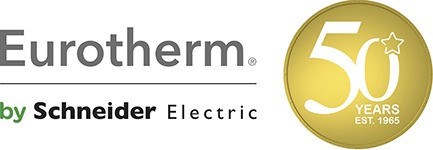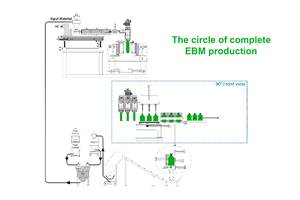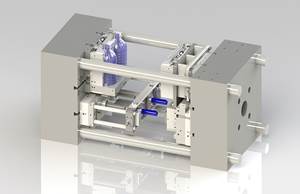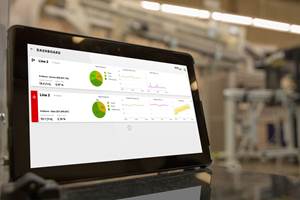Industry Veteran Reflects on the History of Controls
This year marks the 50th anniversary of Eurotherm, a global leader in controls systems for plastics processors of all kinds.

This year marks the 50th anniversary of Eurotherm, a global leader in controls systems for plastics processors of all kinds. In light of this landmark event, we chatted with plastics-industry veteran Steve Schroeder, currently Eurotherm’s business development manager, to reflect on the history of controls and the advances that he has seen first-hand over the course of his 38-year career in the industry.
Plastics Technology: Steve, Eurotherm is celebrating a landmark anniversary this year—50 years in operation. There must have been many changes that you have seen happen in the industry since you started out as well as for Eurotherm?
Schroeder: Yes, Eurotherm has come a long way, diversifying into other industrial electronics areas creating many world firsts with many innovative product developments. What still is clear to our engineers today, is that customer process problems and finding ways to solve them have always been the key focus point enabling those leaps forward for so many years. So it’s no surprise then that many Eurotherm employees have been with the business for most of their careers.
Plastics Technology: You started working in plastics with EPCO, which made injection molding machines. Now, 38 years ago the technology would have been very different? What stands out for you?
Schroeder: Back then, most machines were run with relays, timers, limit switches and manual throttle valves.
Plastics Technology: And what were you using at that time for plastics processing?
Schroeder: We offered as a standard, the Barber Colman (now Eurotherm) 520 temperature controller that was smaller than its predecessor and more precise in control than most controls that were on the market. It was just about that time, in 1974, Barber Colman introduced the Maco IIB rack controller with thumbwheel switches for timers. ‘What a fantastic advancement,’ we thought! It replaced the vast number of relays needed and ran all the sequences through one control rack. It soon became the standard offering on all our new machines. Shortly after, we were retrofitting older machines with the Maco IIB system as well.
Plastics Technology: And what developments came next to improve upon that?
Schroeder: It wasn’t too much later in 1978 that the Maco IV controller was released with a 5-in. display screen, push buttons, built-in temperature control, closed-loop process control and a memory card that was about the size of a credit card that held all the setup of one mold. What we had for the time was a fast operating control with leading edge technology!
Plastics Technology: Like today’s smart phones and computers, technological advances and competition must have been running at a quick pace in our industry. What was the next advancement for Eurotherm?
Schroeder: It sure was. In fact, just five years later in 1983, the futuristic Maco 8000 was launched. The first truly distributed, modular plastics machine control system with its ‘touch screen’ (actually horizontal/vertical grid pattern) operator stations and its many single, large card holding plastic modules that occupied a vast amount of cabinet space. Oh, and let’s not forget the ‘8-Track Tape’ sized, single mold set up memory cartridge. It was faster than the previous offering and many of the North American OEMs began using it as their main control in various formats.
As the leading remanufacturer and retrofitter in the industry, we offered it in a conversion package with a hydraulic modification to run closed-loop process control for both applications. This helped molders bring their machines up to the current standards for plastic processing without buying new machinery.
Plastics Technology: As machines became more sleek in design and manufacturers were downsizing footprints, cabinet space was a big issue as most cabinets were large to house all those modules. What change came about for Eurotherm to compensate?
Schroeder: It was about eight years later, in 1991, that the single rack Maco 4500 came along with its updated 12-in. screen, integrated pushbuttons and small memory cartridge that held up to 15 mold set ups. And in 1996, our patented Impact closed-loop process control feature was introduced as the first automatic adaptive tuned injection process control algorithm and it became a huge seller. The Maco 4500 was sleek looking, reduced the amount of cabinet space and wiring that was required with previous controls, and it was fast. That first IMPACT design still stands out amongst all the innovations over this time. Its reputation and acceptance as the best in its field rapidly grew and remained for many years to come.
Plastics Technology: Since those huge advancements was there anything since that had the same impact?
Schroeder: In fact, you could argue that it wasn't surpassed until 2006 and the release of the Maco Compact and its great number of advancements in size, a full (this time real) touchscreen HMI and a reduced footprint that made the previous offering look huge in comparison. It stores over 500 recipes internally, has more advanced features that all other systems combined with response and processing times measured in milliseconds. Now that’s fast!
Plastics Technology: Steve, it has been interesting to hear from your perspective so what do you see happening next?
Schroeder: When I started in this industry, I never thought I would see such an evolution of controlling machinery processing like I have. It’s 2015 and I say wholeheartedly that the advancements in machinery control systems is still running at a rampant pace. Just reflecting upon the recent NPE, the amount of new and highly advanced control systems on new machines was amazing. Features that even had some looking like large iPhones.
It will be interesting to say the least, to see where it goes next. I think that there is no way to accurately predict the future in controls but to say they will certainly advance at the continuing pace.
Plastics Technology: And so, what is next for Eurotherm?
Schroeder: We will continue to design and develop new products and systems to keep up with the demands of plastic processing. And, if the last 50 years is anything to go by, it will be impressive. Especially with the added strength and scope that the integration with Schneider- Electric offers to Eurotherm. This means for us, truly anything is possible. If I may add, I have to say that all these years, it has been a real pleasure to have been involved both directly and indirectly with Eurotherm products and their people in working together to enhance the operation and functionality of molding machinery and the processing of plastic.

Related Content
How Was K 2022 for Blow Molding?
Over a dozen companies emphasized sustainability with use of foam and recycle, lightweighting and energy savings, along with new capabilities in controls, automation and quick changeovers.
Read MoreGet Color Changes Right In Extrusion Blow Molding
Follow these best practices to minimize loss of time, material and labor during color changes in molding containers from bottles to jerrycans. The authors explore what this means for each step of the process, from raw-material infeed to handling and reprocessing tails and trim.
Read MoreAt NPE, Cypet to Show Latest Achievements in Large PET Containers
Maker of one-stage ISBM machines will show off new sizes and styles of handled and stackable PET containers, including novel interlocking products.
Read MoreHow Inline Vision Inspection Can Minimize Scrap in Molding
Once viewed by injection and blow molders as a necessary evil, machine vision technology today can continuously monitor and improve production while reducing costs.
Read MoreRead Next
Understanding Melting in Single-Screw Extruders
You can better visualize the melting process by “flipping” the observation point so that the barrel appears to be turning clockwise around a stationary screw.
Read MoreWhy (and What) You Need to Dry
Other than polyolefins, almost every other polymer exhibits some level of polarity and therefore can absorb a certain amount of moisture from the atmosphere. Here’s a look at some of these materials, and what needs to be done to dry them.
Read More














.png;maxWidth=300;quality=90)













